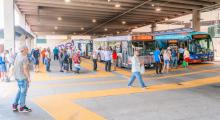 Key Trends and Assumptions
Key Trends and Assumptions

The following trends and assumptions provide a quick overview of some of the high-level issues related to Strong Connections. They are intended to provide a baseline understanding of emerging trends, preferences, and opportunities that may affect how Colorado Springs will grow and change in the coming years. This foundation sets up PlanCOS to provide tailored policy direction and implementation strategies. More background information can be found in Appendix A: State of the City Snapshots.
Transportation
- Over the next 20 years, it is assumed that most of the miles traveled by city residents and visitors will continue to be by individual motorized vehicle. However, trends of reduced per capita vehicle miles of travel and lower rates of motor vehicle ownership are expected to continue.
- In response to changes in travel behavior and technology, with increasingly convenient access to transportation options other than owner-occupied motor vehicles, demand for alternative modes of transportation, such as transit and ridesharing, is expected to grow.
- Over time, proven and emerging technologies will continue to dramatically change our vehicle mix and the way we travel (in some cases, by reducing our need to travel at all). Vehicles of various types will become substantially more autonomous, smart technologies will be increasingly deployed in the management of our systems, and our fleet will likely become more electrified.
- Other new mass transit technologies have the unproven potential to change the way we travel and transport goods (e.g. vacuum transport and magnetic levitation).
- As the city grows and becomes more urban in places, demand is expected to increase for intra- and inter-city transit, as well as for localized non-motorized options.
- The Colorado Springs Airport is anticipated to continue to adapt to emerging travel markets and technologies and to further diversify its roles and functions beyond traditional air travel.
- Transportation choices, such as public transit, walking, or biking, require higher levels of density and connected land use patterns in order to be successful. Therefore, not all options should be expected to be equally available throughout the city.
Utilities and Stormwater
- Stormwater infrastructure needs and requirements will have substantial cost and physical development impacts throughout the city. The interrelated system flood control and water quality ponds, conveyance facilities, and other structures that the city is ultimately responsive for, will continue to grow, along with the regulatory requirements associated with designing and operating them.
- Smart controls and management represent a very significant trend: Colorado Springs Utilities (CSU) will invest substantially in smart meters, which will open up options including net and two way metering and demand side pricing management.
- Energy storage technology is improving along with automobile technology and will allow opportunities for capture of lower cost off-peak energy as well as energy from renewable sources, including microgrid energy installations at the neighborhood level.
- CSU works continually to secure water supplies for the coming decades. Per capita water use continues to decline; however, the water supply is susceptible to the impact of multi-year droughts and more can be done to provide for a more sustainable water supply for the city and possibly the Pikes Peak Region as a whole. Over the past few decades, ratepayers have made significant contributions to infrastructure, infrastructure redundancy, and planning for future water supply and infrastructure needs.
- Over the next 30 years, CSU will see a significant transformation of the electric utility industry as technology drives more cost effective renewable energy resources, distributed generation, demand-side management, energy storage, and Smart Grid opportunities. At the same time, per capita electric sales are declining and environmental regulations are expected to increase. These changes will drive the need to partner more closely with customers as CSU utilizes both customer-owned and CSU-owned resources to manage power supply and consumption.
- Over the past two decades, natural gas demand-side management and energy efficiency measures have resulted in the annual use per residential customer to decline by approximately 25 percent. Despite declining use per customer, natural gas demand is expected to increase slightly due largely to the increase in population. CSU’s natural gas usage is predominantly driven by weather-sensitive heating loads. The annual, peak-day, and peak-hour forecasts of natural gas customer requirements into the future is the starting point for ensuring a safe, economical, and reliable supply to meet customer demand going forward. CSU continues to explore ways to reduce both peak-hour and peak-day natural gas demand on the system.
- Communications have and will continue to evolve rapidly with ever new technologies. Maintaining cutting edge communications facilities will help attract high tech industries and a highly skilled workforce.
Strong Connection Typologies & Framework
The concepts within this chapter define types of streets, corridors, and utilities based on their location and function within the city. They provide direction for mobility across all modes of transportation, and also encompass the need for and development of utility, stormwater, and communications connections from the local to regional scale. Although it is common for transportation and utilities typologies to overlap and interrelate, there are enough differences to support separate typologies for each category. Our city’s green infrastructure is also an essential part of our system of connections, and our waterways in particular, are corridors for a multitude of purposes. The role of green infrastructure and trails in our connections is addressed primarily in Chapter 7. Although we recognize their importance, we have not created separate typologies for the airport or railroads that carry freight.
